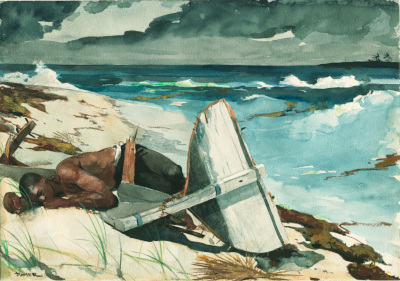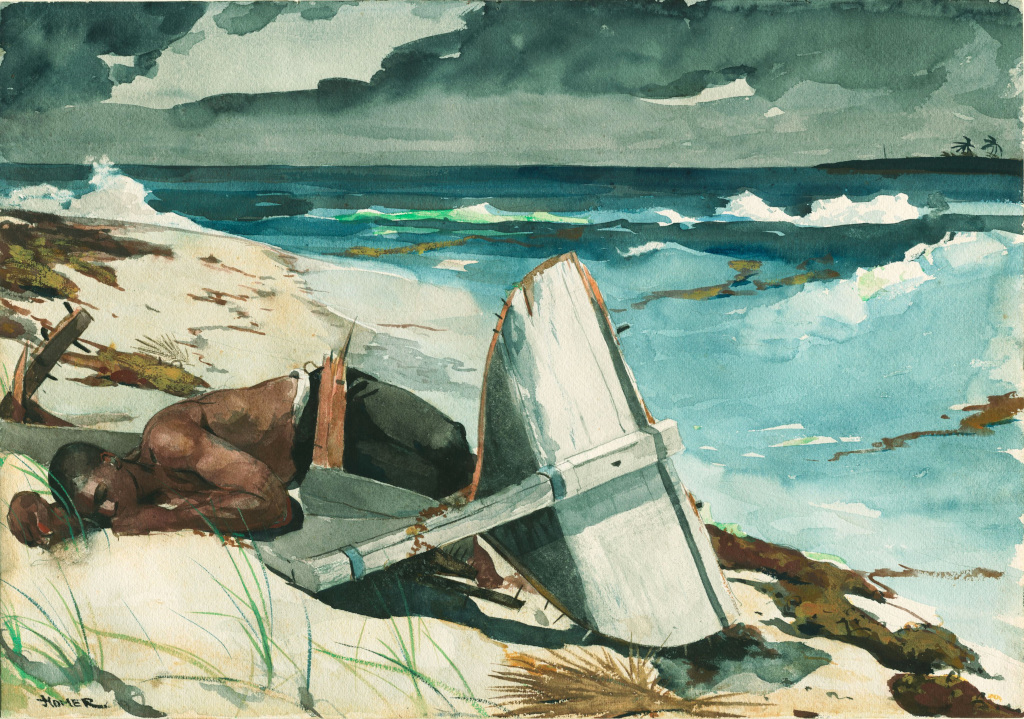 Buy Art Prints Now
Buy Art Prints Nowfrom Amazon
* As an Amazon Associate, and partner with Google Adsense and Ezoic, I earn from qualifying purchases.
After the Hurricane, Bahamas is a watercolour painting by American artist, Winslow Homer. The original artwork now resides at the Art Institute of Chicago, though other variants of it may exist elsewhere.
The artist would focus on seascapes in different parts of his career and eventually he would focus on shipwrecks specifically. Homer travelled to the Caribbean several times and would often walk along the shore, discovering all sorts of things that had been washed ashore. Sadly, shipwrecks were not uncommon in this region at the time and he decided to incorporate some of these scenes into his own work. The item in front of us here was regarding the Bahamas, and shows the aftermath of a terrible storm which sank many ships and smaller boats. The artist also included black figures in his work in a style that was not common at the time. He felt a level of sympathy for their plight and avoided using the stereotypical styles in depicting them that most other artists had used up to that point. He wanted the public to perhaps change their perceptions and also to re-consider how they saw different communities. In the case of After the Hurricane, Bahamas, however, the issue of race is almost irrelevant, as we are simply dealing with an unfortunate individual who was a victim of the ferocity of nature. Homer himself would capture the beauty and evil of the sea, where it could be stunning visually, but also dangerous to those who interacted with it on a daily basis.
We find within this composition the young man washed up on the shore, alongside what is left of his small fishing boat which lays on its side. The sail post has long since been lost, which would have left him at the sea's mercy. Despite the awful circumstances in this painting, some elements of it are actually upbeat, with some bright blue tones used for the waves to the right. One can imagine this island setting with bright sun and a normally tranquil environment. Homer would use different styles of watercolour for this painting, with transparent and opaque additions fused together. He would also use specific techniques such as rewetting, blotting and scraping, having initially drawn out the main forms using graphite. The watercolour is 54cm in width and 38cm tall. The environment of locations such as the Bahamas can change in an instant, and we can already understand here how the region seems to be approaching calm, seemingly unaware of what went before, were it not for the items strewn around in the foreground.
Research has suggested that the artist spent his second trip to the Bahamas in the period of 1898-1899. It is then that this watercolour would have been produced. Although he like to work from his studio, he would often take a pad out with him to sketch around the island. We do know that he also visited Bermuda, Cuba and Florida in later life, always interested in new ideas for his work. Homer loved Maine most of all, setting up a studio here, but the Caribbean offered him something different which could inspire new ideas. The colourful environment and bright light also seemed to suit his artistic style, both in oils and watercolours. Today we remember him for his seascapes most of all, but within that he would take on a number of sub-genres, such as the shipwreck example found here. Such content had fallen out of fashion over the 19th century but Homer worked in the manner that he wanted to, rather than just trying to pander to the whims of the public or art collectors.




